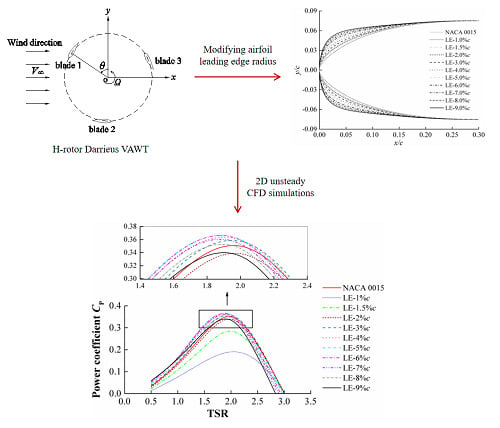Numerical Investigation on the Effects of Airfoil Leading Edge Radius on the Aerodynamic Performance of H-Rotor Darrieus Vertical Axis Wind Turbine
Abstract
1. Introduction
2. Airfoil Modification Scheme
3. CFD Simulations
3.1. Geometric Modeling
3.2. Numerical Settings
3.3. Mesh Independence Study
3.4. Computational Model Validation
4. Results and Discussion
4.1. Power Characteristics
4.2. Torque Characteristics
4.3. Flow Field Characteristics
4.3.1. Vorticity Field
4.3.2. Pressure Distribution
5. Conclusions
- The computational model validation study shows that the present 2D CFD model is applicable to the performance prediction of H-rotor Darrieus VAWT. The overprediction of the power coefficient is due to the neglect of the losses of blade tips and main shaft as well as rotor arms.
- The optimum TSR is invariant to the airfoil leading edge radius of H-rotor Darrieus VAWT. The best aerodynamic characteristics are achieved by the LE-5%c model below the optimum TSR and the LE-3%c model beyond the optimum TSR.
- CPmax first increases rapidly to a maximum value, and then decreases slowly, with an increase of the airfoil leading edge radius. The maximum and minimum value of CP max are obtained for the LE-5%c and LE-1%c model, respectively.
- The torque characteristics and pressure distribution for the single blades with different airfoil leading edge radius show an obvious difference in the upwind region, and a very small difference in the downwind region.
- The airfoil leading edge radius influences the strength, region, and diffusion rate of the vortices, being the main reason for the observed differences in instantaneous torque coefficient and power coefficient. The vortices of the LE-1%c model are stronger, larger, and diffuse slower than those of the LE-2%c and LE-5%c model at the optimum TSR.
Author Contributions
Funding
Conflicts of Interest
References
- Saeidi, D.; Sedaghat, A.; Alamdari, P.; Alemrajabi, A.A. Aerodynamic design and economical evaluation of site specific small vertical axis wind turbines. Appl. Energy 2013, 101, 765–775. [Google Scholar] [CrossRef]
- Guo, J.; Zeng, P.; Lei, L. Performance of a straight-bladed vertical axis wind turbine with inclined pitch axes by wind tunnel experiments. Energy 2019, 174, 553–561. [Google Scholar] [CrossRef]
- Hui, I.; Cain, B.E.; Dabiri, J.O. Public receptiveness of vertical axis wind turbines. Energy Policy 2018, 112, 258–271. [Google Scholar] [CrossRef]
- Bangga, G.; Lutz, T.; Dessoky, A.; Krämer, E. Unsteady Navier-Stokes studies on loads, wake, and dynamic stall characteristics of a two-bladed vertical axis wind turbine. J. Renew. Sustain. Energy 2017, 9, 053303. [Google Scholar] [CrossRef]
- Li, Q.; Maeda, T.; Kamada, Y.; Hiromori, Y.; Nakai, A.; Kasuya, T. Study on stall behavior of a straight-bladed vertical axis wind turbine with numerical and experimental investigations. J. Wind Eng. Ind. Aerodyn. 2017, 164, 1–12. [Google Scholar] [CrossRef]
- Douak, M.; Aouachria, Z.; Rabehi, R.; Allam, N. Wind energy systems: Analysis of the self-starting physics of vertical axis wind turbine. Renew. Sustain. Energy Rev. 2018, 81, 1602–1610. [Google Scholar] [CrossRef]
- Wang, Y.; Shen, S.; Li, G.; Huang, D.; Zheng, Z. Investigation on aerodynamic performance of vertical axis wind turbine with different series airfoil shapes. Renew. Energy 2018, 126, 801–818. [Google Scholar] [CrossRef]
- Dessoky, A.; Bangga, G.; Lutz, T.; Krämer, E. Aerodynamic and aeroacoustic performance assessment of H-rotor darrieus VAWT equipped with wind-lens technology. Energy 2019, 175, 76–97. [Google Scholar] [CrossRef]
- Tjiu, W.; Marnoto, T.; Mat, S.; Ruslan, M.H.; Sopian, K. Darrieus vertical axis wind turbine for power generation II: Challenges in HAWT and the opportunity of multi-megawatt Darrieus VAWT development. Renew. Energy 2015, 75, 560–571. [Google Scholar] [CrossRef]
- Chong, W.T.; Wang, X.H.; Wong, K.H.; Mojumder, J.C.; Poh, S.C.; Saw, L.H.; Lai, S.H. Performance assessment of a hybrid solar-wind-rain eco-roof system for buildings. Energy Build. 2016, 127, 1028–1042. [Google Scholar] [CrossRef]
- Kumar, R.; Raahemifar, K.; Fung, A.S. A critical review of vertical axis wind turbines for urban applications. Renew. Sustain. Energy Rev. 2018, 89, 281–291. [Google Scholar] [CrossRef]
- Shukla, V.; Kaviti, A.K. Performance evaluation of profile modifications on straight-bladed vertical axis wind turbine by energy and Spalart Allmaras models. Energy 2017, 126, 766–795. [Google Scholar] [CrossRef]
- Bak, C.; Skrzypiński, W.; Fischer, A.; Gaunaa, M.; Brønnum, N.F.; Kruse, E.K. Wind tunnel tests of an airfoil with 18% relative thickness equipped with vortex generators. J. Phys. Conf. Ser. 2018, 1037, 022044. [Google Scholar] [CrossRef]
- Luo, D.; Huang, D.; Sun, X. Passive flow control of a stalled airfoil using a microcylinder. J. Wind Eng. Ind. Aerodyn. 2017, 170, 256–273. [Google Scholar] [CrossRef]
- Wong, K.H.; Chong, W.T.; Poh, S.C.; Shiah, Y.C.; Sukiman, N.L.; Wang, C.T. 3D CFD simulation and parametric study of a flat plate deflector for vertical axis wind turbine. Renew. Energy 2018, 129, 32–55. [Google Scholar] [CrossRef]
- Shahizare, B.; Nik-Ghazali, N.; Chong, W.T.; Tabatabaeikia, S.; Izadyar, N.; Esmaeilzadeh, A. Novel investigation of the different Omni-direction-guide-vane angles effects on the urban vertical axis wind turbine output power via three-dimensional numerical simulation. Energy Convers. Manag. 2016, 117, 206–217. [Google Scholar] [CrossRef]
- Santoli, L.D.; Albo, A.; Garcia, D.A.; Bruschi, D.; Cumo, F. A preliminary energy and environmental assessment of a micro wind turbine prototype in natural protected areas. Sustain. Energy Technol. Assess. 2014, 8, 42–56. [Google Scholar] [CrossRef]
- Loganathan, B.; Chowdhury, H.; Mustary, I.; Alam, F. An experimental study of a cyclonic vertical axis wind turbine for domestic scale power generation. Procedia Eng. 2015, 105, 686–691. [Google Scholar] [CrossRef]
- Ismail, M.F.; Vijayaraghavan, K. The effects of aerofoil profile modification on a vertical axis wind turbine performance. Energy 2015, 80, 20–31. [Google Scholar] [CrossRef]
- Bai, C.J.; Lin, Y.Y.; Lin, S.Y.; Wang, W.C. Computational fluid dynamics analysis of the vertical axis wind turbine blade with tubercle leading edge. J. Renew. Sustain. Energy 2015, 7, 033124. [Google Scholar] [CrossRef]
- Wang, Z.; Zhuang, M. Leading-edge serrations for performance improvement on a vertical-axis wind turbine at low tip-speed-ratios. Appl. Energy 2017, 208, 1184–1197. [Google Scholar] [CrossRef]
- Lin, S.Y.; Lin, Y.Y.; Bai, C.J.; Wang, W.C. Performance analysis of vertical-axis-wind-turbine blade with modified trailing edge through computational fluid dynamics. Renew. Energy 2016, 99, 654–662. [Google Scholar] [CrossRef]
- Zamani, M.; Nazari, S.; Moshizi, S.A.; Maghrebi, M.J. Three dimensional simulation of J-shaped Darrieus vertical axis wind turbine. Energy 2016, 116, 1243–1255. [Google Scholar] [CrossRef]
- Zamani, M.; Maghrebi, M.J.; Varedi, S.R. Starting torque improvement using J-shaped straight-bladed Darrieus vertical axis wind turbine by means of numerical simulation. Renew. Energy 2016, 95, 109–126. [Google Scholar] [CrossRef]
- Zamani, M.; Maghrebi, M.J.; Moshizi, S.A. Numerical study of airfoil thickness effects on the performance of J-shaped straight blade vertical axis wind turbine. Wind Struct. 2016, 22, 595–616. [Google Scholar] [CrossRef]
- Mohamed, M.H. Criticism study of J-Shaped darrieus wind turbine: Performance evaluation and noise generation assessment. Energy 2019, 177, 367–385. [Google Scholar] [CrossRef]
- Sobhani, E.; Ghaffari, M.; Maghrebi, M.J. Numerical investigation of dimple effects on darrieus vertical axis wind turbine. Energy 2017, 133, 231–241. [Google Scholar] [CrossRef]
- Lositaño, I.C.M.; Danao, L.A.M. Steady wind performance of a 5 kW three-bladed H-rotor Darrieus Vertical Axis Wind Turbine (VAWT) with cambered tubercle leading edge (TLE) blades. Energy 2019, 175, 278–291. [Google Scholar] [CrossRef]
- Shih, T.H.; Liou, W.W.; Shabbir, A.; Yang, Z.; Zhu, J. A new k-e eddy viscosity model for high Reynolds number turbulent flows. Comput. Fluids 1995, 24, 227–238. [Google Scholar] [CrossRef]
- Song, C.; Zheng, Y.; Zhao, Z.; Zhang, Y.; Li, C.; Jiang, H. Investigation of meshing strategies and turbulence models of CFD simulations of vertical axis wind turbine. J. Renew. Sustain. Energy 2015, 7, 033111. [Google Scholar] [CrossRef]
- Castelli, M.R.; Englaro, A.; Benini, E. The Darrieus wind turbine: Proposal for a new performance prediction model based on CFD. Energy 2011, 36, 4919–4934. [Google Scholar] [CrossRef]
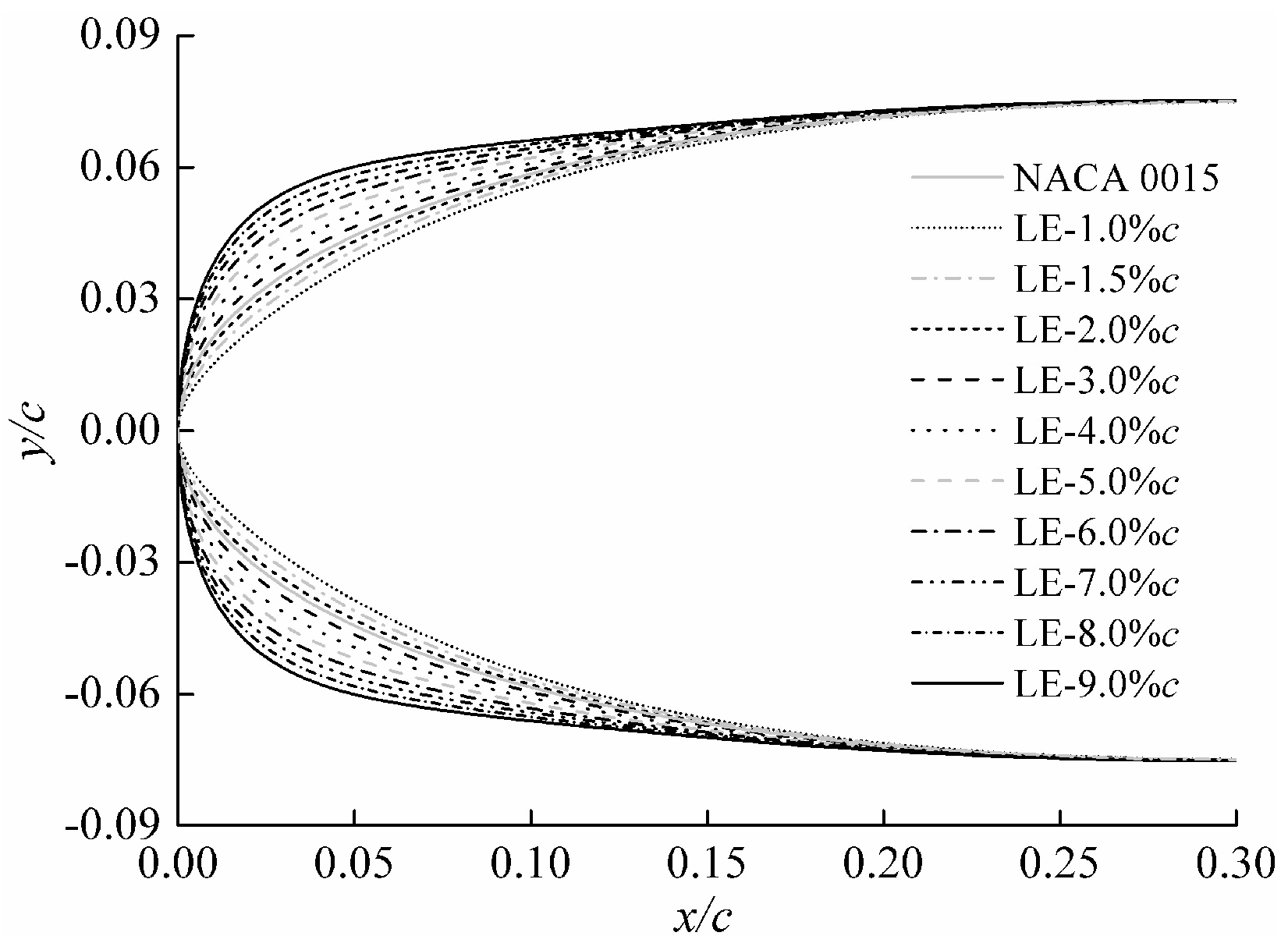
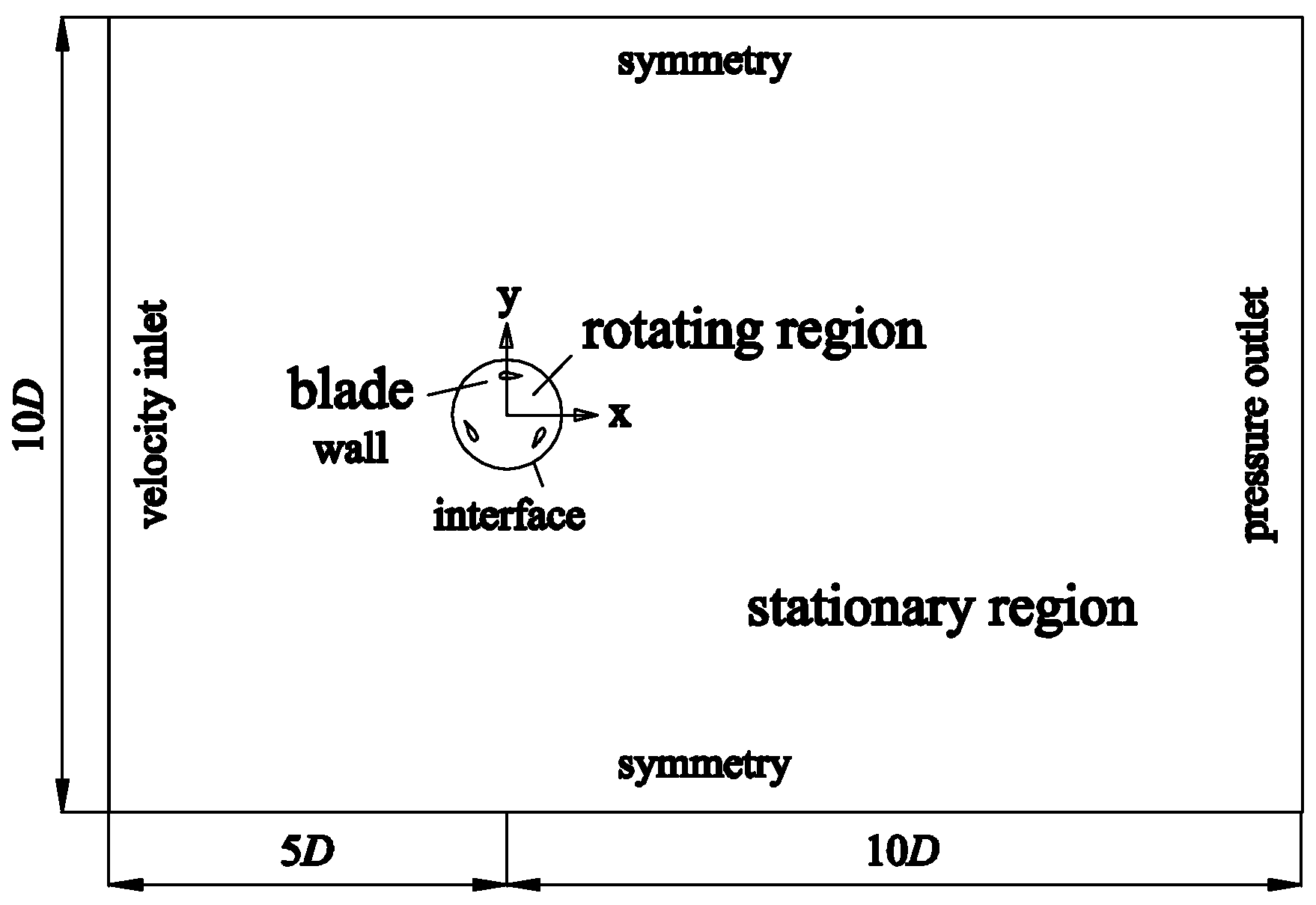
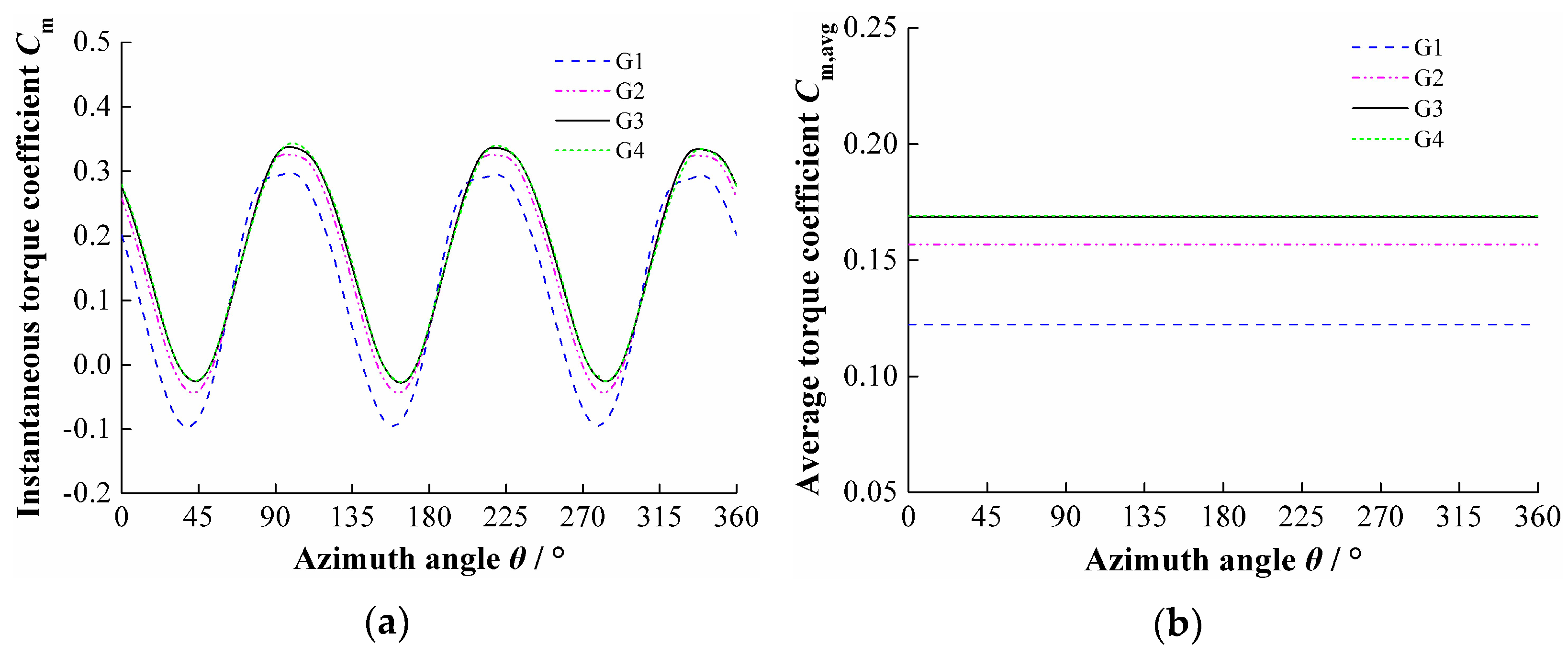

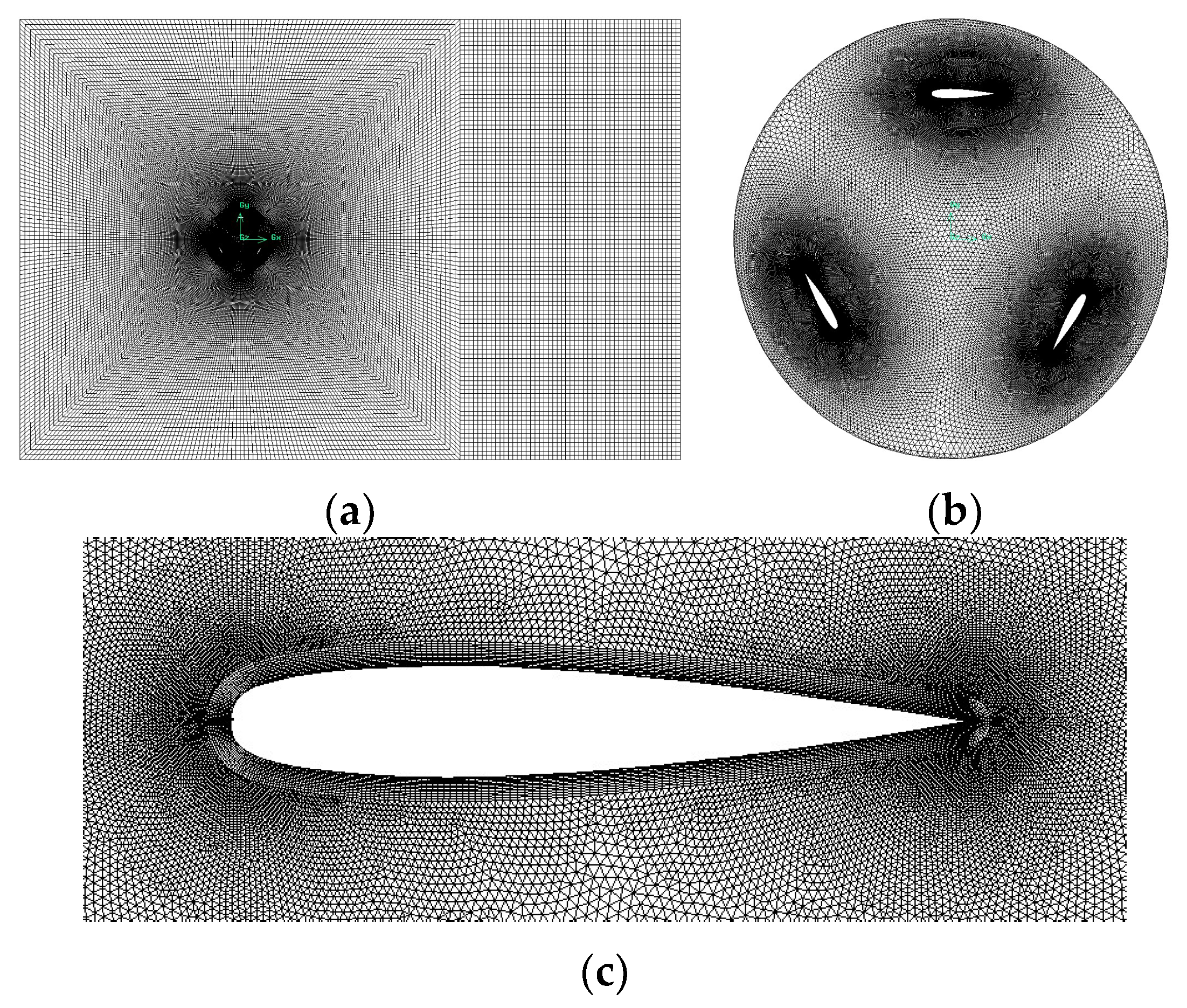
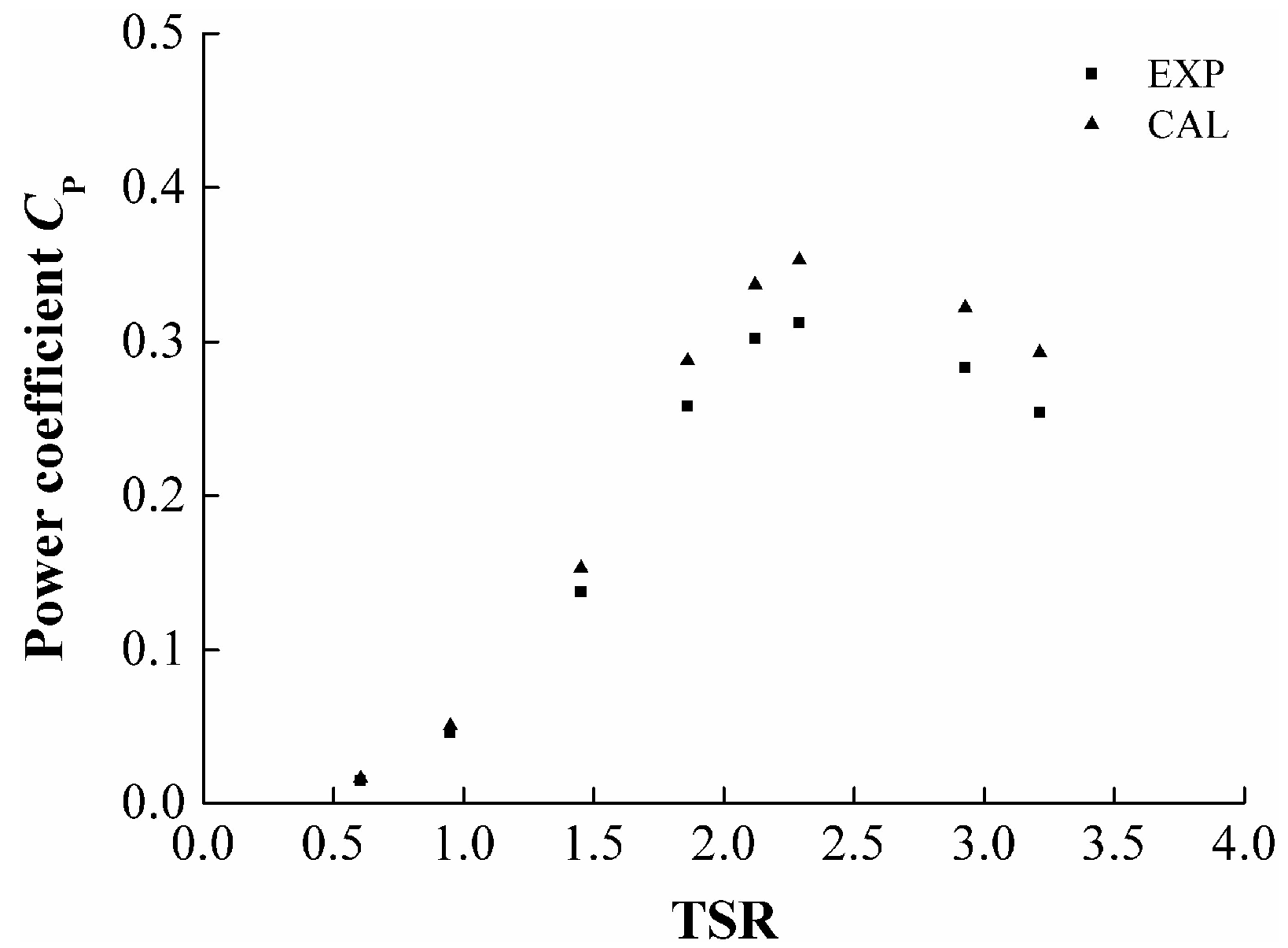
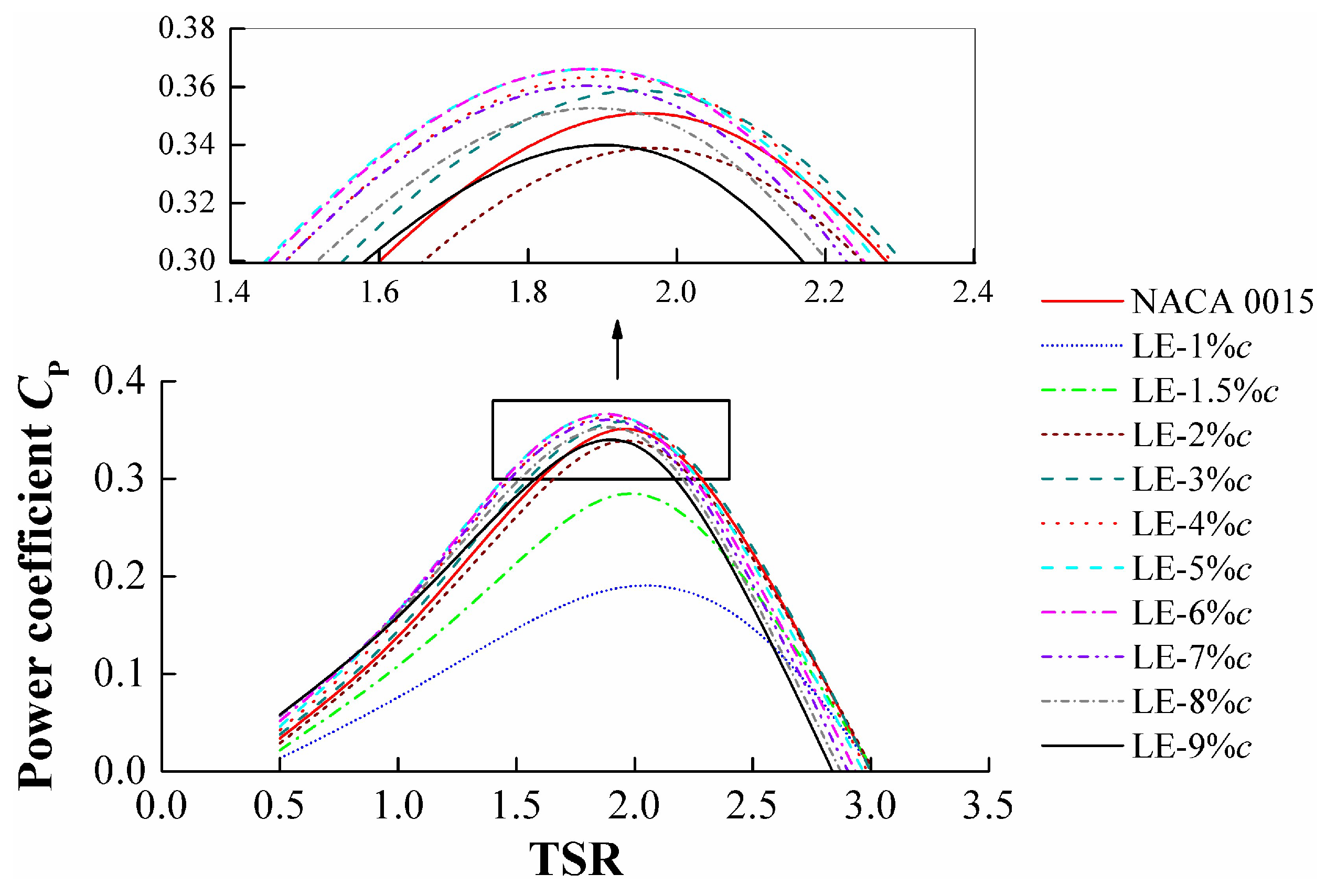
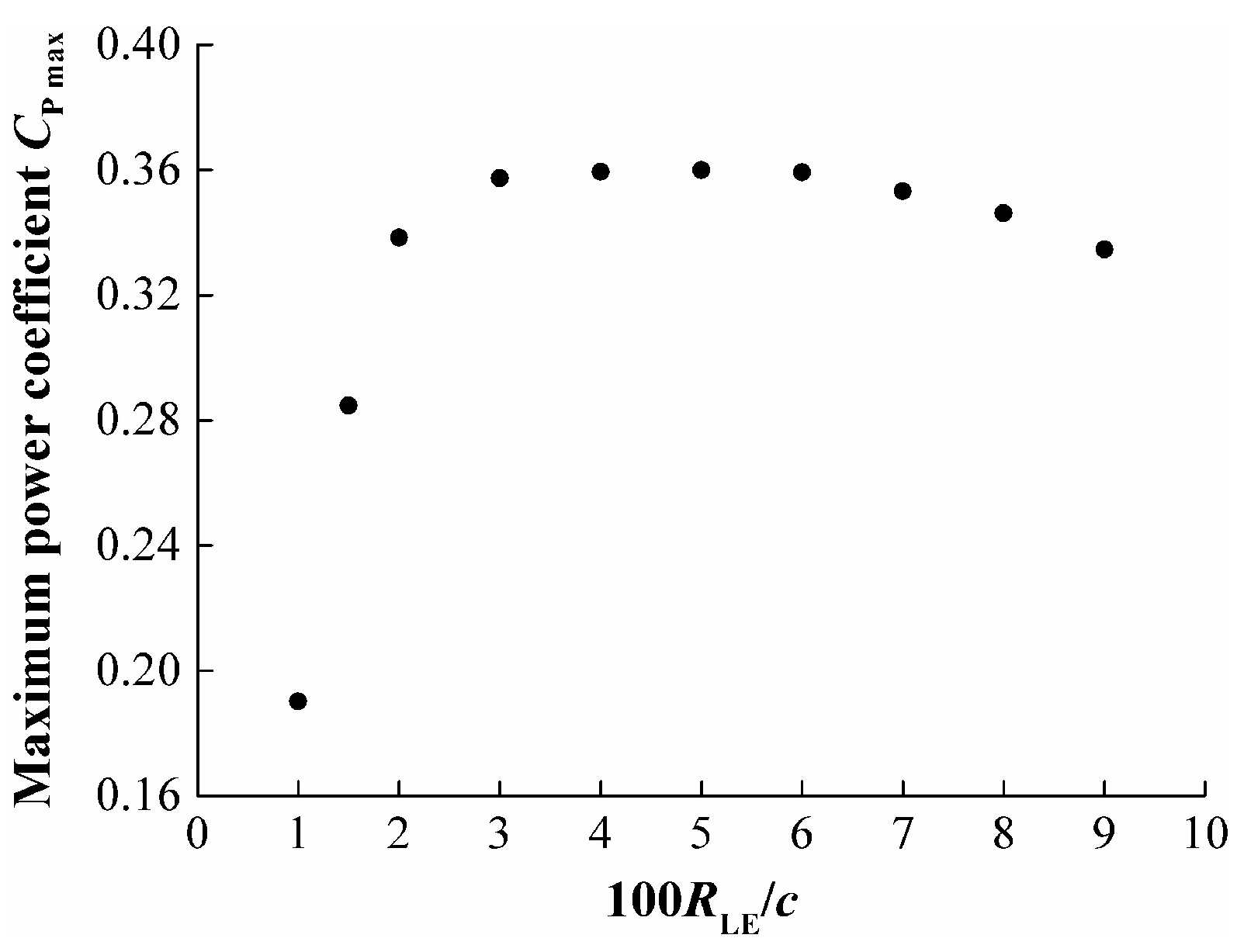
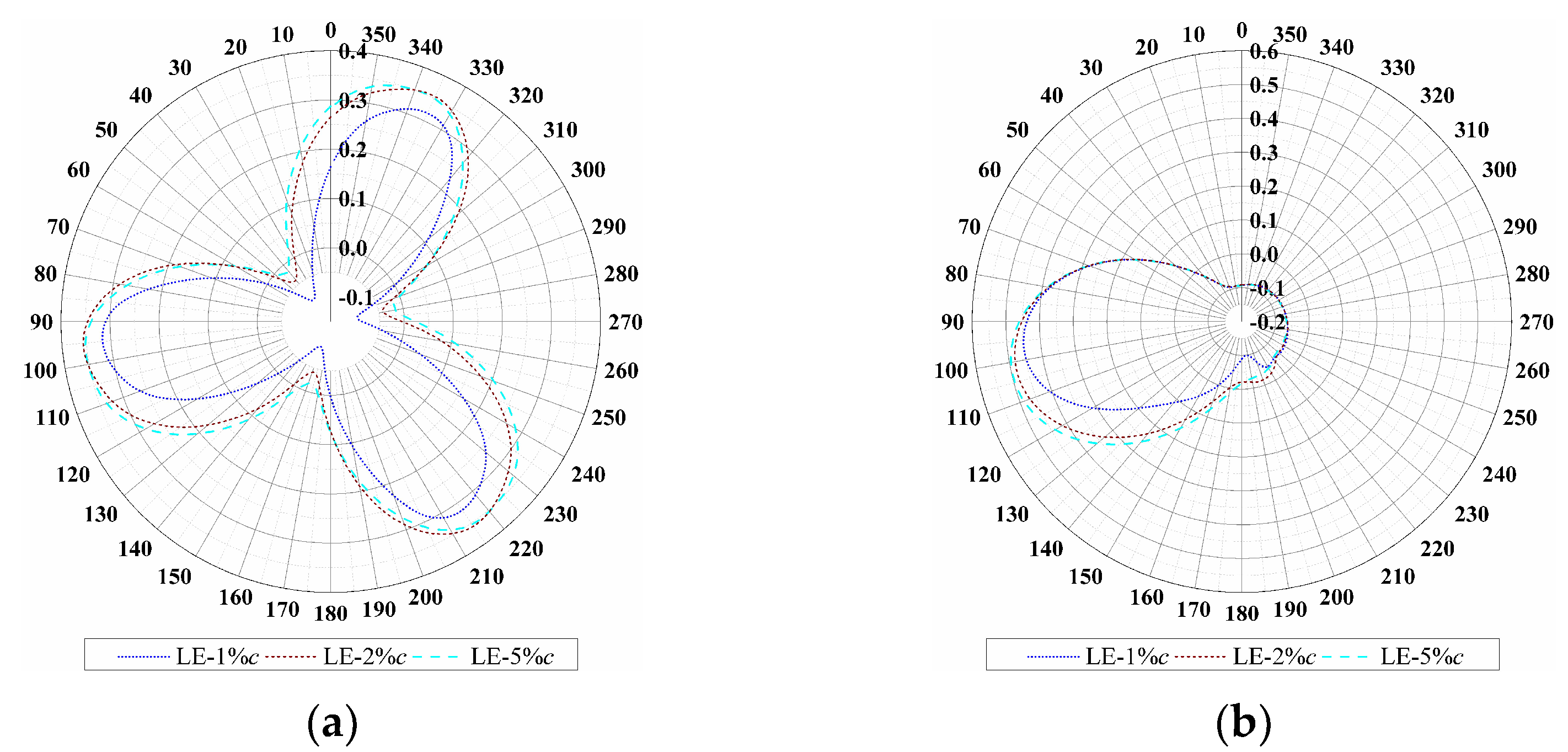
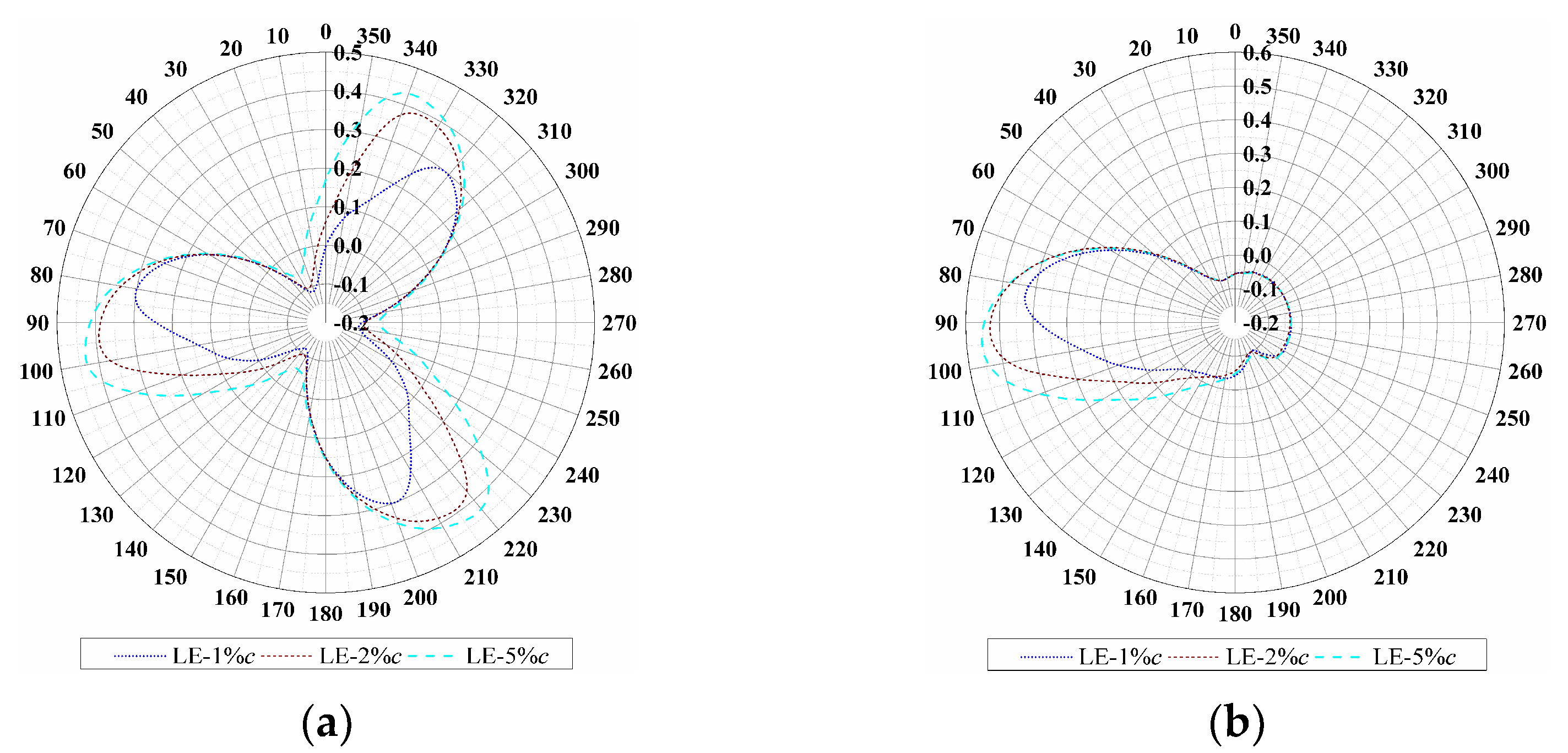
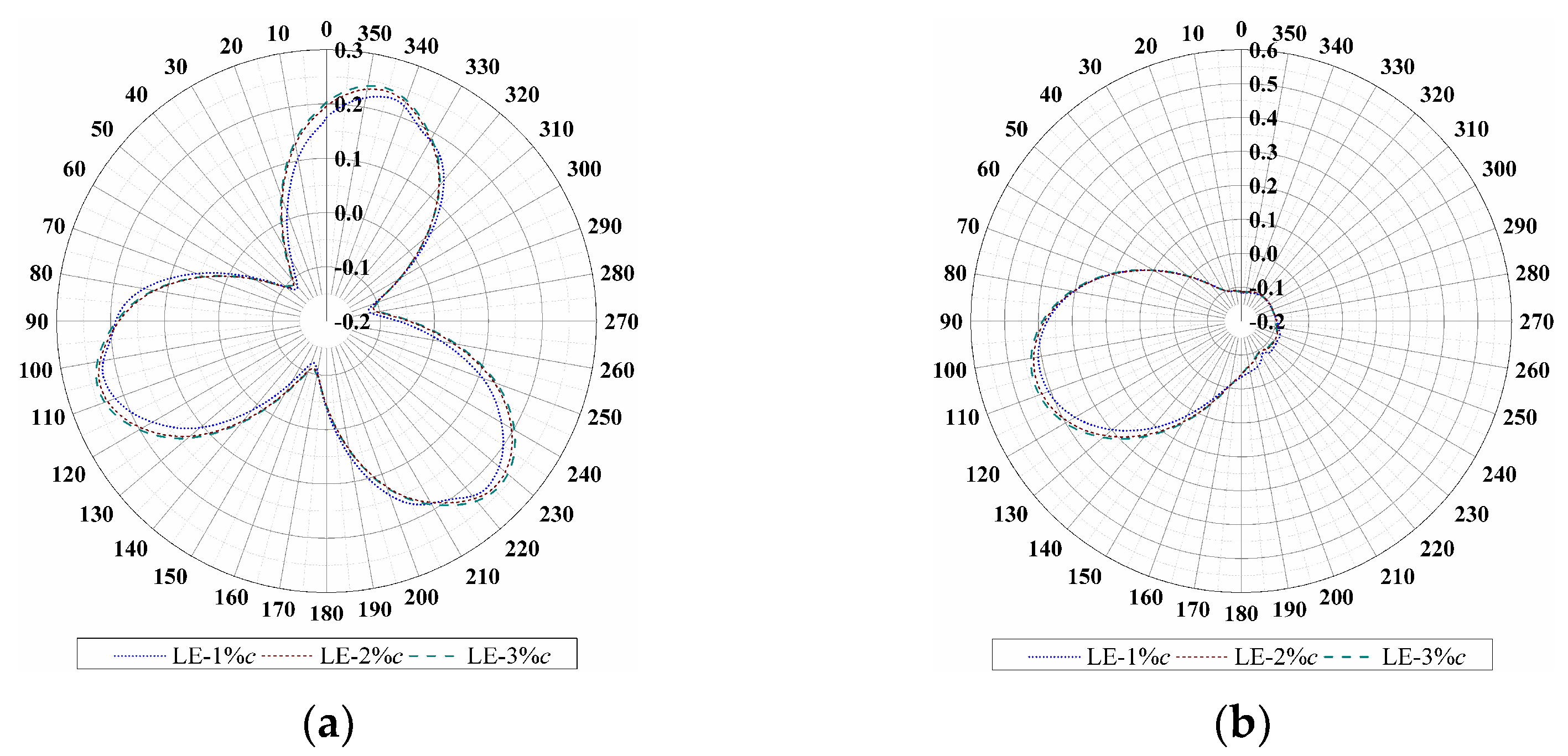
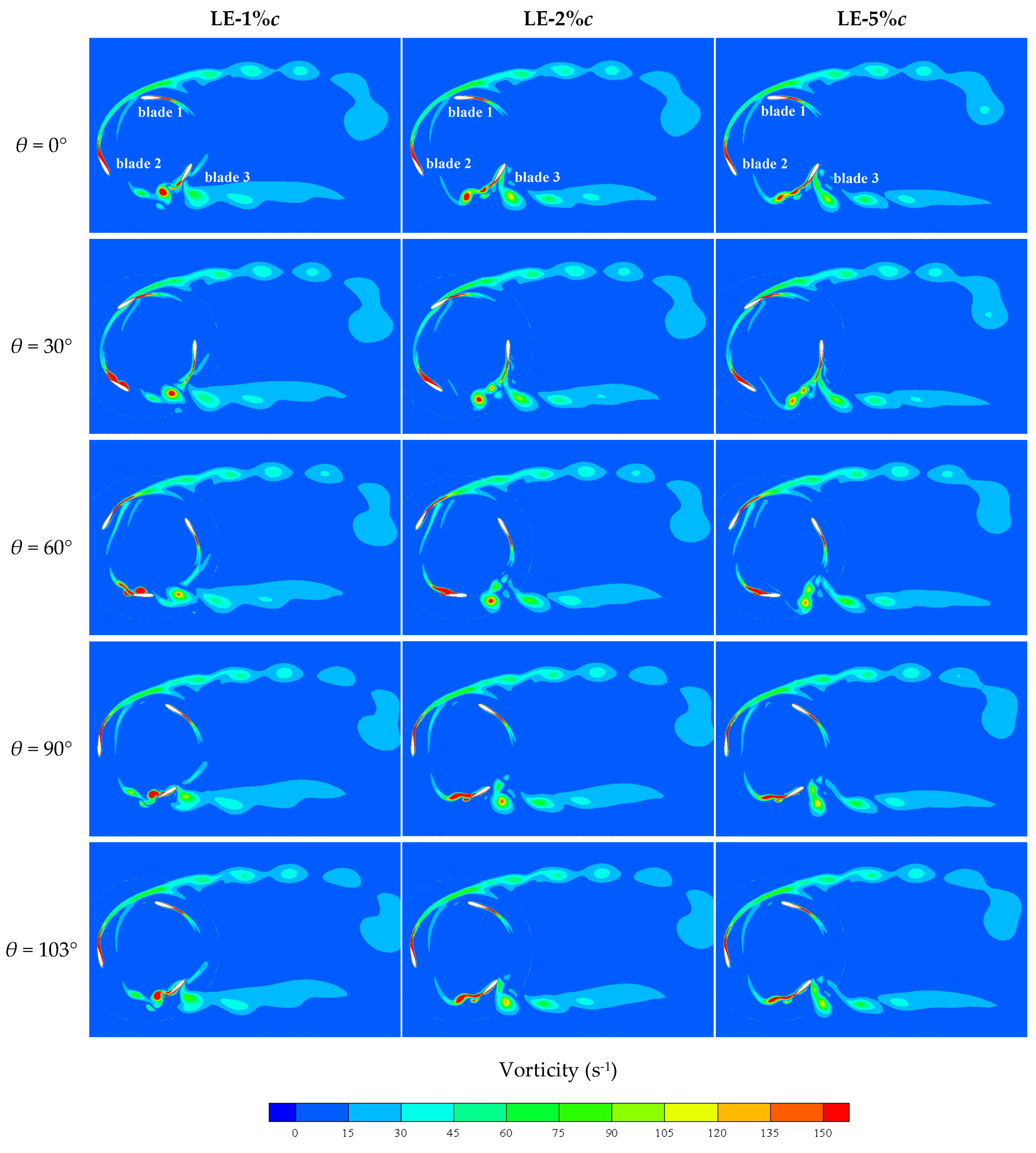
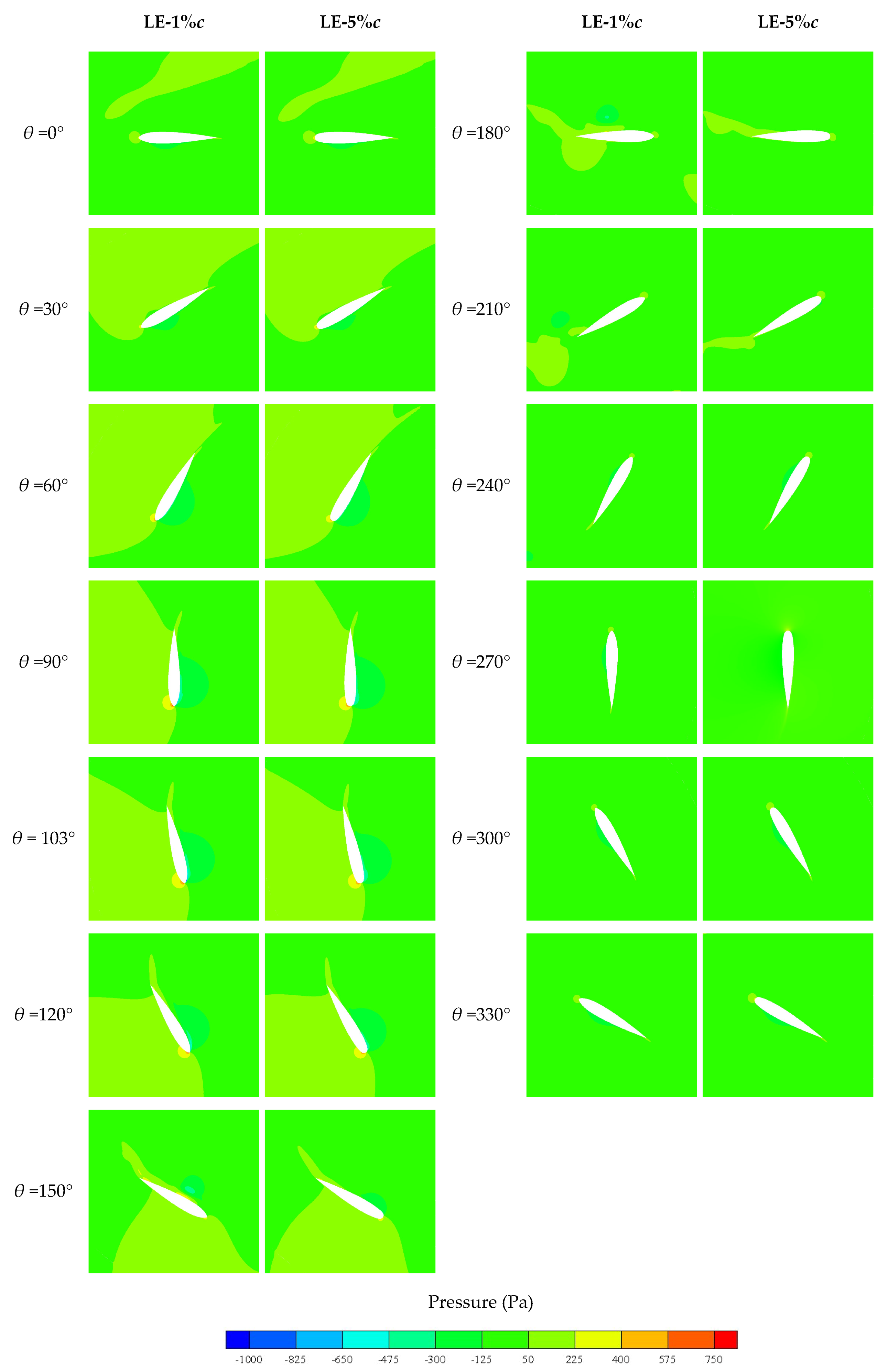
| Parameter | Symbol | Value | Name |
|---|---|---|---|
| Leading edge radius (m) | RLE | 1%c | LE-1%c |
| 1.5%c | LE-1.5%c | ||
| 2%c | LE-2%c | ||
| 3%c | LE-3%c | ||
| 4%c | LE-4%c | ||
| 5%c | LE-5%c | ||
| 6%c | LE-6%c | ||
| 7%c | LE-7%c | ||
| 8%c | LE-8%c | ||
| 9%c | LE-9%c |
| Parameters | Symbol | Value |
|---|---|---|
| Wind velocity (m/s) | V∞ | 8 |
| Blade number (-) | N | 3 |
| Rotor diameter (mm) | D | 1650 |
| Rotor height (mm) | H | 1 (2D simulation) |
| Blade chord length (mm) | c | 375 |
| Installation angle (°) | γ | 0 |
| Blade attachment (mm) | - | 30%c |
| Parameters | Value |
|---|---|
| Air density (kg/m3) | 1.225 |
| Air viscosity (kg/m·s) | 1.7894 × 10−5 |
| Boundary type of inlet | Velocity inlet, 8 m/s |
| Boundary type of outlet | Pressure outlet |
| Boundary type of lateral sides | Symmetry |
| Boundary type of blades | No-slip wall |
| Boundary type of contact region for rotating and stationary region | Sliding grid interface |
| Solver type | Pressure Based |
| Viscous model | Realizable k-ε |
| Pressure—velocity coupling scheme | SIMPLE |
| Gradient discretization scheme | Green-Gauss Node Based |
| Pressure discretization scheme | Standard |
| Convective term discretization scheme | Second order upwind |
| Residual error | 1 × 10−4 |
| Physical time step | T/360 |
| Grid No. | Node Number on the Airfoil (Suction Surface × Pressure Surface) | Total Number of Cells | Maximum y+ on Airfoils |
|---|---|---|---|
| G1 | 50 × 50 | 45202 | 9.5 |
| G2 | 100 × 100 | 91224 | 8.1 |
| G3 | 200 × 200 | 189014 | 6.2 |
| G4 | 300 × 300 | 322961 | 5.0 |
© 2019 by the authors. Licensee MDPI, Basel, Switzerland. This article is an open access article distributed under the terms and conditions of the Creative Commons Attribution (CC BY) license (http://creativecommons.org/licenses/by/4.0/).
Share and Cite
Song, C.; Wu, G.; Zhu, W.; Zhang, X.; Zhao, J. Numerical Investigation on the Effects of Airfoil Leading Edge Radius on the Aerodynamic Performance of H-Rotor Darrieus Vertical Axis Wind Turbine. Energies 2019, 12, 3794. https://doi.org/10.3390/en12193794
Song C, Wu G, Zhu W, Zhang X, Zhao J. Numerical Investigation on the Effects of Airfoil Leading Edge Radius on the Aerodynamic Performance of H-Rotor Darrieus Vertical Axis Wind Turbine. Energies. 2019; 12(19):3794. https://doi.org/10.3390/en12193794
Chicago/Turabian StyleSong, Chenguang, Guoqing Wu, Weinan Zhu, Xudong Zhang, and Jicong Zhao. 2019. "Numerical Investigation on the Effects of Airfoil Leading Edge Radius on the Aerodynamic Performance of H-Rotor Darrieus Vertical Axis Wind Turbine" Energies 12, no. 19: 3794. https://doi.org/10.3390/en12193794
APA StyleSong, C., Wu, G., Zhu, W., Zhang, X., & Zhao, J. (2019). Numerical Investigation on the Effects of Airfoil Leading Edge Radius on the Aerodynamic Performance of H-Rotor Darrieus Vertical Axis Wind Turbine. Energies, 12(19), 3794. https://doi.org/10.3390/en12193794



